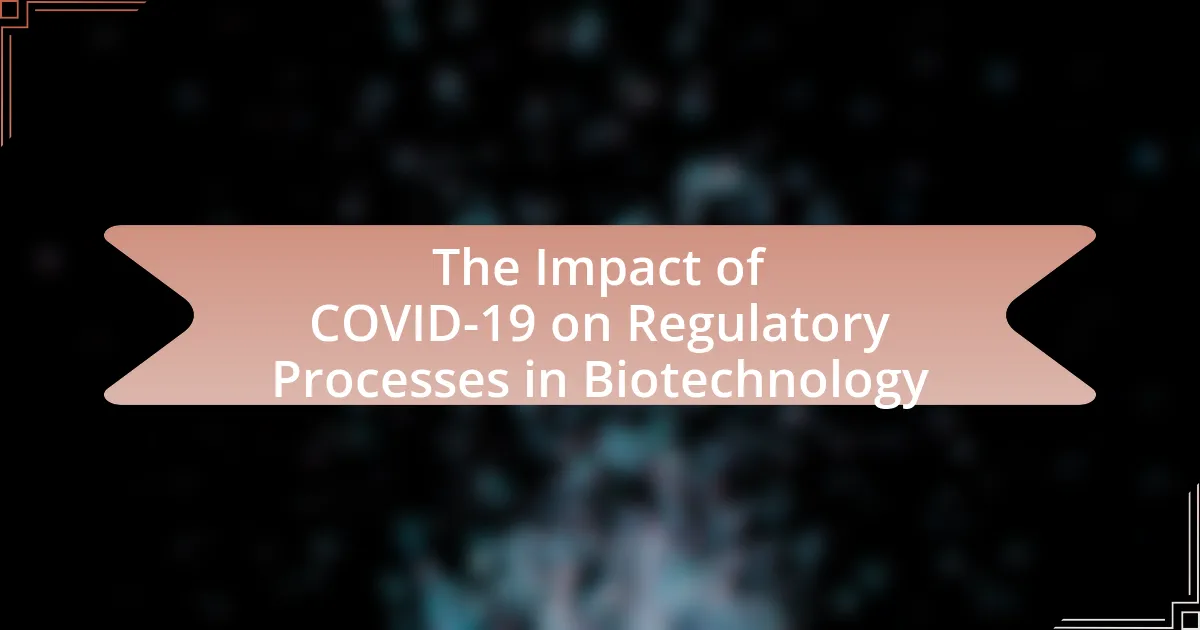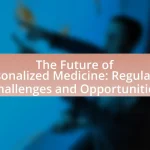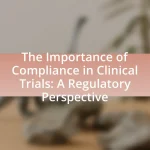The article examines the significant impact of COVID-19 on regulatory processes in biotechnology, highlighting expedited review processes and increased collaboration between regulatory agencies and biotech companies. It details how emergency use authorizations (EUAs) implemented by agencies like the FDA and EMA facilitated rapid access to COVID-19 diagnostics, treatments, and vaccines, resulting in faster approval timelines. The article also discusses specific regulatory changes, challenges faced during the pandemic, and the potential long-term effects on regulatory practices, emphasizing the importance of understanding these dynamics for future public health responses and biotechnology innovations. Additionally, it explores the role of technology and communication strategies in enhancing regulatory efficiency and the ethical considerations surrounding equity and access in healthcare.
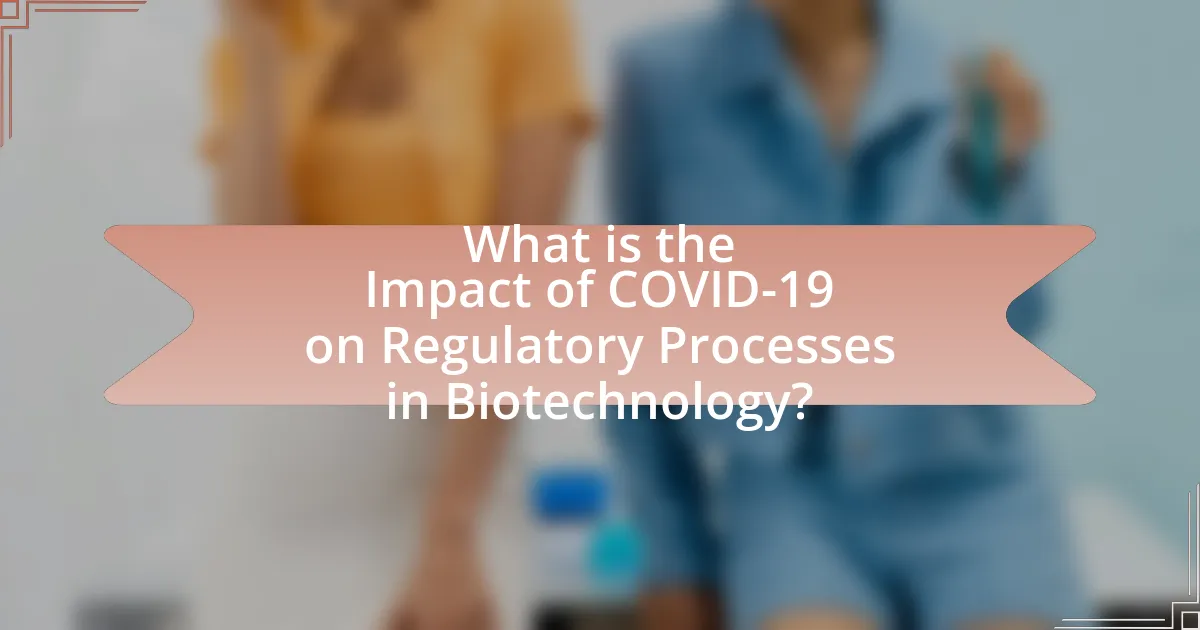
What is the Impact of COVID-19 on Regulatory Processes in Biotechnology?
The impact of COVID-19 on regulatory processes in biotechnology has been significant, leading to expedited review processes and increased collaboration between regulatory agencies and biotech companies. Regulatory bodies, such as the FDA and EMA, implemented emergency use authorizations to facilitate rapid access to COVID-19 diagnostics, treatments, and vaccines, which resulted in a faster approval timeline compared to traditional processes. For instance, the FDA granted emergency use authorization for the Pfizer-BioNTech vaccine just months after the onset of the pandemic, a process that typically takes years. This shift has also encouraged the adoption of innovative regulatory frameworks, such as rolling reviews and adaptive trial designs, which may influence future regulatory practices beyond the pandemic.
How has the pandemic altered regulatory frameworks in biotechnology?
The pandemic has significantly altered regulatory frameworks in biotechnology by accelerating the approval processes for vaccines and therapeutics. Regulatory agencies, such as the U.S. Food and Drug Administration (FDA) and the European Medicines Agency (EMA), implemented emergency use authorizations (EUAs) to expedite the availability of COVID-19 vaccines and treatments, allowing for faster clinical trials and data review. For instance, the Pfizer-BioNTech and Moderna vaccines received EUAs within months of initiating clinical trials, a process that typically takes years. This shift has led to a more flexible regulatory environment, emphasizing rapid response and adaptability in crisis situations, which may influence future regulatory practices beyond the pandemic.
What specific regulatory changes have been implemented during COVID-19?
During COVID-19, specific regulatory changes implemented include expedited review processes for vaccines and therapeutics, allowing for emergency use authorizations (EUAs) by the FDA and similar agencies worldwide. These changes aimed to accelerate the availability of critical medical products to combat the pandemic. For instance, the FDA issued EUAs for COVID-19 vaccines, enabling their distribution and use before full approval, which typically requires extensive clinical trials. Additionally, regulatory agencies relaxed certain clinical trial requirements, allowing for remote monitoring and virtual visits to ensure continuity of research while adhering to public health guidelines. These measures were essential in facilitating rapid responses to the health crisis and ensuring timely access to necessary medical interventions.
How have these changes affected the speed of biotechnology innovations?
The changes in regulatory processes due to COVID-19 have significantly accelerated the speed of biotechnology innovations. For instance, emergency use authorizations (EUAs) allowed for rapid deployment of COVID-19 vaccines, with the Pfizer-BioNTech vaccine receiving EUA just under a year after the virus was identified, a process that typically takes several years. Additionally, regulatory agencies like the FDA implemented streamlined review processes and increased collaboration with biotech firms, which further expedited the development and approval of new therapies and diagnostics. These adaptations demonstrate a clear correlation between regulatory flexibility during the pandemic and the accelerated pace of biotechnological advancements.
Why is understanding these impacts important for the biotechnology sector?
Understanding the impacts of COVID-19 on regulatory processes is crucial for the biotechnology sector because it directly influences the speed and efficiency of product development and approval. The pandemic has led to expedited regulatory pathways, such as the Emergency Use Authorization in the United States, which allows for quicker access to critical therapies and vaccines. This shift in regulatory dynamics can enhance the sector’s ability to respond to public health emergencies, as evidenced by the rapid development and deployment of COVID-19 vaccines, which were authorized in record time due to these new regulatory frameworks.
What are the potential long-term effects on regulatory practices?
The potential long-term effects on regulatory practices in biotechnology include increased flexibility in approval processes and a greater emphasis on digital tools for compliance and monitoring. The COVID-19 pandemic has accelerated the adoption of expedited review mechanisms, as seen with the Emergency Use Authorizations granted by the FDA, which may lead to permanent changes in how regulatory bodies assess and approve new biotechnological products. Additionally, the reliance on virtual inspections and remote data submissions during the pandemic has demonstrated the feasibility of these methods, potentially resulting in a more streamlined and efficient regulatory framework in the future.
How might these changes influence public health outcomes?
Changes in regulatory processes in biotechnology due to COVID-19 may significantly enhance public health outcomes by accelerating the development and approval of vaccines and therapeutics. For instance, the expedited review processes implemented by agencies like the FDA allowed for the rapid deployment of COVID-19 vaccines, which were developed and authorized for emergency use in record time, demonstrating a 95% efficacy rate in clinical trials. This swift action not only mitigated the immediate health crisis but also set a precedent for future biotechnological innovations, potentially leading to quicker responses to emerging health threats. Furthermore, the increased collaboration between regulatory bodies and biotech firms fosters a more agile environment for research and development, ultimately improving the overall efficiency of public health interventions.
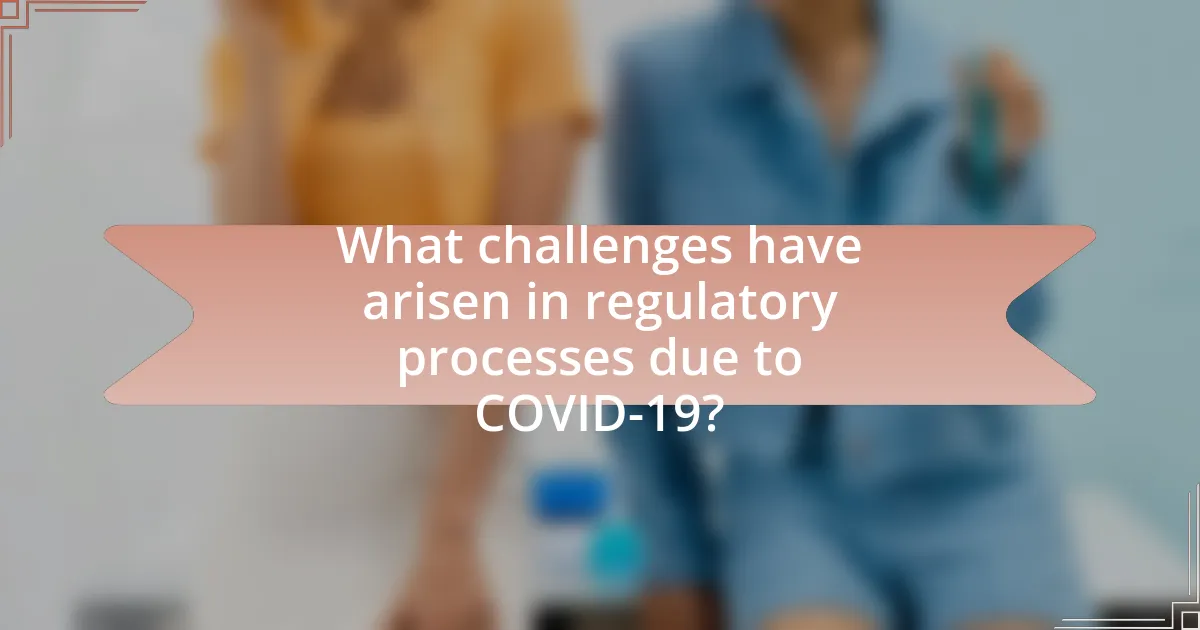
What challenges have arisen in regulatory processes due to COVID-19?
Regulatory processes in biotechnology have faced significant challenges due to COVID-19, primarily including delays in approvals, resource allocation issues, and the need for rapid adaptation to new health guidelines. The pandemic caused a backlog in regulatory reviews as agencies prioritized COVID-related applications, leading to slower timelines for other biotechnology products. Additionally, many regulatory bodies experienced workforce disruptions, which hindered their ability to conduct inspections and evaluations. The urgency of the pandemic also necessitated the development of expedited pathways for vaccine and therapeutic approvals, creating a tension between speed and thoroughness in regulatory oversight. These challenges have been documented in reports from organizations such as the FDA and EMA, highlighting the impact of COVID-19 on the efficiency and effectiveness of regulatory frameworks in the biotechnology sector.
How have regulatory agencies adapted to the challenges posed by the pandemic?
Regulatory agencies have adapted to the challenges posed by the pandemic by implementing expedited review processes and utilizing digital technologies for remote assessments. For instance, the U.S. Food and Drug Administration (FDA) introduced the Coronavirus Treatment Acceleration Program (CTAP) to facilitate the rapid development of COVID-19 treatments, allowing for faster approvals and emergency use authorizations. Additionally, agencies like the European Medicines Agency (EMA) adopted rolling reviews, enabling them to assess data as it becomes available rather than waiting for complete submissions. These adaptations have been crucial in responding to urgent public health needs while maintaining safety and efficacy standards.
What new technologies have been utilized to streamline regulatory processes?
Artificial intelligence (AI) and machine learning (ML) have been utilized to streamline regulatory processes in biotechnology. These technologies enhance data analysis, enabling faster review of applications and compliance documents by automating repetitive tasks and identifying patterns in large datasets. For instance, the FDA has implemented AI-driven tools to expedite the evaluation of drug applications, significantly reducing the time required for approval. Additionally, blockchain technology is being explored for its potential to improve transparency and traceability in regulatory submissions, ensuring data integrity and facilitating real-time monitoring of compliance.
How have communication strategies changed between agencies and biotech firms?
Communication strategies between agencies and biotech firms have evolved to become more collaborative and transparent due to the pressures of the COVID-19 pandemic. Agencies, such as the FDA and EMA, have increased their engagement with biotech firms through regular updates, virtual meetings, and expedited feedback processes, which contrasts with the previously more formal and less frequent interactions. This shift is evidenced by the implementation of initiatives like the FDA’s COVID-19 vaccine development guidance, which provided real-time communication and support to biotech companies, facilitating faster regulatory approvals. Additionally, the use of digital platforms for communication has become standard, allowing for more efficient information exchange and quicker responses to emerging challenges in the biotech sector.
What ethical considerations have emerged in biotechnology regulation during COVID-19?
Ethical considerations that have emerged in biotechnology regulation during COVID-19 include the balance between rapid vaccine development and ensuring safety and efficacy. The urgency of the pandemic led to accelerated approval processes, raising concerns about the thoroughness of clinical trials and potential long-term effects of vaccines. For instance, the Emergency Use Authorization (EUA) allowed vaccines to be distributed before completing all standard testing phases, prompting debates about informed consent and the ethical implications of administering unproven treatments to diverse populations. Additionally, issues of equity surfaced, as marginalized communities often faced barriers to access, highlighting the need for fair distribution practices. These considerations reflect the complex interplay between public health needs and ethical standards in biotechnology regulation during a global health crisis.
How are equity and access being addressed in regulatory decisions?
Regulatory decisions are addressing equity and access by implementing frameworks that prioritize underserved populations and ensure fair distribution of resources. For instance, during the COVID-19 pandemic, regulatory agencies like the FDA and EMA emphasized equitable access to vaccines and treatments by establishing guidelines that require consideration of diverse demographic factors in clinical trials. This approach is supported by data indicating that marginalized communities faced higher rates of infection and mortality, necessitating targeted interventions to ensure they receive adequate healthcare resources.
What role does public trust play in regulatory processes during a health crisis?
Public trust is crucial in regulatory processes during a health crisis as it influences compliance with health guidelines and acceptance of interventions. High levels of public trust lead to greater adherence to regulations, which is essential for effective disease control and management. For instance, during the COVID-19 pandemic, countries with higher public trust in government institutions experienced better compliance with health measures, resulting in more effective containment of the virus. Research published in the journal “Health Affairs” by Gollust et al. (2020) indicates that trust in public health authorities significantly correlates with the public’s willingness to accept vaccines and follow health directives. Thus, public trust directly impacts the success of regulatory measures in managing health crises.

What future trends can be anticipated in biotechnology regulation post-COVID-19?
Future trends in biotechnology regulation post-COVID-19 will likely include increased flexibility in regulatory frameworks, expedited approval processes, and enhanced collaboration between regulatory agencies and industry stakeholders. The pandemic highlighted the need for rapid responses to health crises, prompting agencies like the FDA to implement emergency use authorizations, which may lead to permanent changes in how regulations are structured. Additionally, the rise of digital health technologies and telemedicine during the pandemic is expected to drive regulatory adaptations that accommodate these innovations, ensuring safety while promoting timely access to biotechnological advancements.
How might regulatory processes evolve in response to lessons learned from the pandemic?
Regulatory processes are likely to evolve by incorporating more flexible frameworks and expedited pathways for approval, as demonstrated during the COVID-19 pandemic. The rapid development and emergency use authorization of vaccines highlighted the need for adaptive regulatory mechanisms that can respond swiftly to public health crises. For instance, the U.S. Food and Drug Administration (FDA) utilized the Emergency Use Authorization (EUA) to facilitate quicker access to vaccines, which may lead to permanent adaptations in regulatory practices to allow for faster responses in future health emergencies. Additionally, increased collaboration between regulatory agencies and biotechnology firms during the pandemic has shown the benefits of streamlined communication and data sharing, which could become standard practice moving forward.
What innovations in regulatory science are likely to emerge?
Innovations in regulatory science likely to emerge include the increased use of real-time data analytics and adaptive regulatory frameworks. These advancements are driven by the need for faster responses to public health emergencies, as demonstrated during the COVID-19 pandemic, where expedited vaccine approvals were facilitated through novel regulatory pathways. The FDA’s Emergency Use Authorization (EUA) process exemplifies this shift, allowing for quicker access to critical therapies while maintaining safety standards. Additionally, the integration of artificial intelligence and machine learning in regulatory assessments is expected to enhance decision-making efficiency and accuracy, as seen in the FDA’s pilot programs that leverage these technologies for drug review processes.
How can biotechnology companies prepare for future regulatory changes?
Biotechnology companies can prepare for future regulatory changes by implementing proactive compliance strategies and engaging in continuous monitoring of regulatory developments. These companies should establish dedicated teams to analyze emerging regulations and adapt their practices accordingly, ensuring alignment with both domestic and international standards. For instance, the rapid evolution of regulations during the COVID-19 pandemic highlighted the need for agility in regulatory affairs, as companies that swiftly adapted to new guidelines were able to maintain their market positions. Additionally, participating in industry associations can provide valuable insights and foster collaboration on best practices, further enhancing preparedness for regulatory shifts.
What best practices can be adopted for navigating regulatory processes in a post-pandemic world?
To navigate regulatory processes in a post-pandemic world, organizations should adopt a proactive approach that includes continuous engagement with regulatory bodies, leveraging technology for compliance, and fostering collaboration across sectors. Continuous engagement with regulatory agencies ensures that organizations stay informed about evolving guidelines and can provide feedback on proposed regulations, which is crucial in a rapidly changing environment. Leveraging technology, such as digital submission platforms and data analytics, enhances efficiency and accuracy in compliance efforts, as evidenced by the increased use of electronic submissions during the pandemic that streamlined processes. Collaboration across sectors, including partnerships with other companies and stakeholders, can facilitate knowledge sharing and best practices, ultimately leading to more effective navigation of regulatory landscapes.
How can companies ensure compliance while fostering innovation?
Companies can ensure compliance while fostering innovation by integrating regulatory considerations into the innovation process from the outset. This approach involves establishing a compliance framework that aligns with innovative practices, ensuring that new products or services meet regulatory standards without stifling creativity. For instance, companies can adopt agile regulatory strategies that allow for iterative testing and feedback, which can accelerate innovation while maintaining adherence to regulations.
Evidence of this can be seen in the biotechnology sector during the COVID-19 pandemic, where companies rapidly developed vaccines while simultaneously navigating complex regulatory landscapes. The U.S. Food and Drug Administration (FDA) implemented Emergency Use Authorizations (EUAs) that facilitated quicker pathways for innovation, demonstrating that regulatory flexibility can coexist with rapid development.
What resources are available for staying updated on regulatory changes?
To stay updated on regulatory changes, professionals can utilize government websites, industry associations, and specialized news outlets. Government websites, such as the U.S. Food and Drug Administration (FDA) and the European Medicines Agency (EMA), provide official updates on regulations and guidelines. Industry associations like the Biotechnology Innovation Organization (BIO) offer resources, newsletters, and webinars focused on regulatory developments. Additionally, specialized news outlets, such as Regulatory Affairs Professionals Society (RAPS) and FierceBiotech, deliver timely news and analysis on regulatory changes affecting the biotechnology sector. These resources ensure that stakeholders remain informed about evolving regulations, particularly in the context of the ongoing impact of COVID-19 on regulatory processes.
